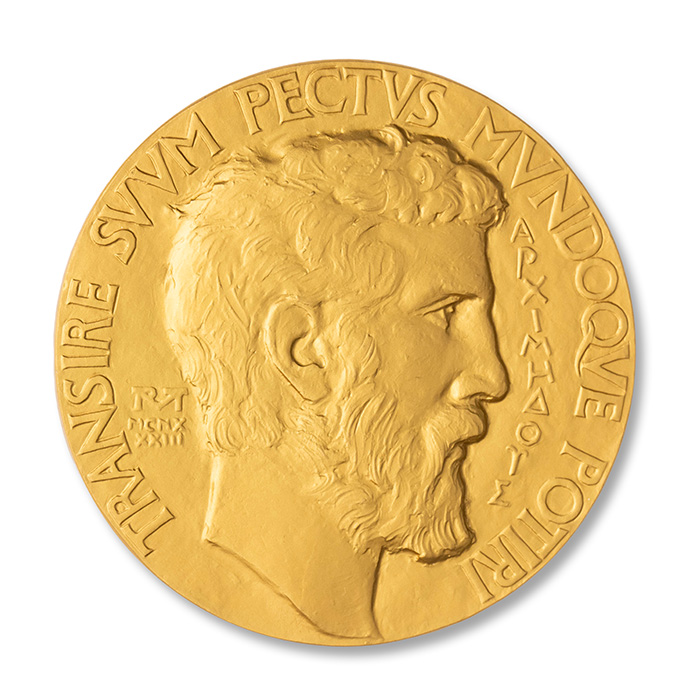Fields Medal
The Fields Medal is awarded every four years on the occasion of the International Congress of Mathematicians to recognize outstanding mathematical achievement for existing work and for the promise of future achievement.
The Fields Medal Committee is chosen by the Executive Committee of the International Mathematical Union and is normally chaired by the IMU President. It is asked to choose at least two, with a strong preference for four, Fields Medalists, and to have regard in its choice to representing a diversity of mathematical fields. A candidate's 40th birthday must not occur before January 1st of the year of the Congress at which the Fields Medals are awarded.
The medals and cash prizes are funded by a trust established by J.C.Fields
at the University of Toronto, which has been supplemented periodically, but is still significantly
underfunded. The discrepancy in 2018 was made up by the University of Toronto and
the Fields Institute.
The name of the Chair of the Committee is made public, but the names of other members of the Committee remain anonymous until the award of the prize at the Congress.
Statutes for the Fields Medal
The details of the Award, the nomination, and the selection can be found in the Statutes for the Award.
Physical Medal
Material - 14KT Gold
Diameter - 63.5 mm
Weight - 169 g
Finish - Sandblasted, Engraved, Gold Plated & Lacquered
Unit Price - approx. 5,500 CAD
Obverse
The head represents Archimedes facing right.
In the field is the word ΑΡXIMHΔΟΥΣ in Greek capitals and the artist's monogram and date RTM, MCNXXXIII.
The inscription reads: TRANSIRE SUUM PECTUS MUNDOQUE POTIRI.
Reverse
The inscription on the tablet reads:
CONGREGATI
EX TOTO ORBE
MATHEMATICI
OB SCRIPTA INSIGNIA
TRIBUERE
It means: "The mathematicians having congregated from the whole world awarded (this medal) because of outstanding writings". The verb form "tribuere" (the first "e" is a long vowel) is a short form of "tribuerunt". In the background there is a representation of Archimedes' sphere being inscribed in a cylinder.
Eberhard Knobloch, August 5, 1998
The Fields Medalists, chronologically listed
2006
- *Grigori Perelman declined to accept the Fields Medal.
1998
- A silver plaque was offered to Andrew J. Wiles as a special tribute from IMU
Former Prize Committees
2022
- Carlos E. Kenig (chair)
Artur Avila
Camillo de Lellis
Michael Hopkins
Antti Kupiainen
Rahul Pandharipande
Alfio Quarteroni
Vera Serganova
Laure St Raymond
Richard Taylor
Weiping Zhang
Tamar Ziegler
2018
- Shigefumi Mori (chair)
Hélène Esnault
Eduard Feireisl
Alice Guionnet
Nigel Hitchin
John Morgan
Hee Oh
Andrei Okounkov
M.S. Raghunathan
Kenneth A. Ribet
Terence Tao
2014
- Ingrid Daubechies (chair)
Luigi Ambrosio
David Eisenbud
Kenji Fukaya
Étienne Ghys
Benedict Gross
Frances Kirwan
János Kollár
Maxim Kontsevich
Michael Struwe
Ofer Zeitouni
Günter M. Ziegler
2010
- László Lovász (chair)
Corrado De Concini
Yakov Eliashberg
Peter Hall
Timothy Gowers
Ngaiming Mok
Stefan Müller
Peter Sarnak
Karen Uhlenbeck
2006
- John M Ball (chair)
Enrico Arbarello
Jeff Cheeger
Donald Dawson
Gerhard Huisken
Curtis McMullen
Alexey Parshin
Tom Spencer
Michèle Vergne
2002
- Yakov Sinai (chair)
James Arthur
Spencer Bloch
Jean Bourgain
Helmut Hofer
Yasutaka Ihara
H. Blaine Lawson
Sergei Novikov
George Papanicolaou
Efim Zelmanov
1998
- Yuri I. Manin (chair)
John Ball
John Coates
J. J. Duistermaat
Michael Freedman
Jürg Fröhlich
Robert MacPherson
Kyoji Saito
Steve Smale
1994
- Mumford (chair)
Caffarelli
Kashiwara
B. Mazur
Schrijver
Sullivan
Tits
Varadhan
1990
- Faddeev (chair)
Atiyah
Bismut
Bombieri
Fefferman
Iwasawa
Lax
Shafarevich
1986
- Moser (chair)
Deligne
Glimm
Hörmander
Ito
Milnor
Novikov
Seshadri
1982
- Carleson (chair)
Araki
Malliavin
Marchuk
Mumford
Nirenberg
Schintzel
C.T.C. Wall
1978
- Montgomery (chair)
Carleson
Eichler
I.M. James
Moser
Prohorov
Szökefalvi-Nagy
Tits
1974
- Chandrasekharan (chair)
Adams
Kodaira
Malgrange
Mostowski
Pontryagin
Tate
Zygmund
1970
- H. Cartan (chair)
Doob
Hirzebruch
Hörmander
Iyanaga
Milnor
Shafarevich
Turán
1966
- de Rham (chair)
Davenport
Deuring
Feller
Lavrentiev
Serre
Spencer
Thom
1962
- Nevanlinna (chair)
P.S. Aleksandrov
Artin
Chern
Chevalley
Whitney
Yosida
1958
- Hopf (chair)
Chandrasekharan
Friedrichs
P. Hall
Kolmogorov
L. Schwartz
Siegel
Zariski
1954
- Weyl (chair)
Bompiani
Bureau
H. Cartan
Ostrowski
Pleijel
Szegö
Titchmarsh
1950
- Bohr (chair)
Ahlfors
Borsuk
Fréchet
Hodge
Kolmogorov
Kosambi
Morse
1936
- Severi (chair)
Carathéodory
G.D. Birkhoff
E. Cartan
Takagi
History of the Fields Medal
At the 1924 International Congress of Mathematicians in Toronto, a resolution was adopted that at each ICM, two gold medals should be awarded to recognize outstanding mathematical achievement. Professor J. C. Fields, a Canadian mathematician who was Secretary of the 1924 Congress, later donated funds establishing the medals, which were named in his honor. In 1966 it was agreed that, in light of the great expansion of mathematical research, up to four medals could be awarded at each Congress.
The Fields Institute, Toronto, Canada, organizes the Fields Medal Symposium. The goals of the program for the Fields Medal Symposium are to present the work of a Fields Medalist and its impact, to explore the potential for future directions and areas of its influence, to provide inspiration to the next generations of mathematicians and scientists, as well as to present the Medalist to a broader public.

